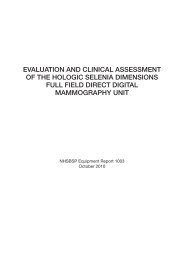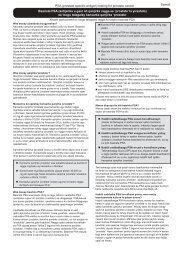reporting lesions in the nhs bowel cancer screening programme
reporting lesions in the nhs bowel cancer screening programme
reporting lesions in the nhs bowel cancer screening programme
You also want an ePaper? Increase the reach of your titles
YUMPU automatically turns print PDFs into web optimized ePapers that Google loves.
8 | Report<strong>in</strong>g Lesions <strong>in</strong> <strong>the</strong> NHS Bowel Cancer Screen<strong>in</strong>g Programme<br />
type mucosa that appears hyperplastic but not dysplastic. As with sporadic juvenile polyps, solitary<br />
Peutz–Jeghers type polyps are most unlikely to demonstrate foci of dysplasia.<br />
3.9.4 Cronkhite–Canada syndrome<br />
We believe that it is most unlikely such cases will present via <strong>the</strong> NHS BCSP, and <strong>the</strong> true diagnosis<br />
may not be recognised by pathological assessment. Such polyps are probably best regarded as<br />
be<strong>in</strong>g of <strong>in</strong>flammatory type.<br />
3.10 O<strong>the</strong>r polyps, <strong>in</strong>clud<strong>in</strong>g carc<strong>in</strong>oids and stromal polyps<br />
Small rectal mucosal nodules, show<strong>in</strong>g <strong>the</strong> characteristic features of h<strong>in</strong>d gut carc<strong>in</strong>oids, are not<br />
uncommon. For pathological <strong>report<strong>in</strong>g</strong> as part of <strong>the</strong> NHS BCSP, we recommend that <strong>the</strong>se are<br />
recorded as ‘o<strong>the</strong>r polyp’ and that <strong>the</strong>ir true nature is recorded <strong>in</strong> free text. Fur<strong>the</strong>rmore, <strong>the</strong>re are<br />
a number of stromal tumours that can also present as polyps. Lipomas and leiomyomas of <strong>the</strong><br />
muscularis mucosae are probably <strong>the</strong> most likely to be seen <strong>in</strong> <strong>the</strong> NHSBCSP, and we recommend<br />
that <strong>the</strong>se are recorded as ‘o<strong>the</strong>r polyp’ and that <strong>the</strong>ir true nature is recorded <strong>in</strong> free text. North<br />
American experience with <strong>bowel</strong> <strong>cancer</strong> screen<strong>in</strong>g <strong>in</strong>dicates that, rarely, o<strong>the</strong>r unusual forms of<br />
stromal tumour can present as polypoid nodules <strong>in</strong> <strong>the</strong> screen<strong>in</strong>g <strong>programme</strong>. Such stromal <strong>lesions</strong><br />
<strong>in</strong>clude ganglioneuroma, neurofibroma, gastro<strong>in</strong>test<strong>in</strong>al stromal tumour (GIST), various forms of<br />
vascular tumour, per<strong>in</strong>eurioma, fibroblastic polyp and epi<strong>the</strong>lioid nerve sheath tumour.<br />
3.11 Shape<br />
The NHS BCSP is not designed to detect flat adenomas because it does not mandate magnify<strong>in</strong>g<br />
endoscopy or chromoendoscopy. Flat adenomas have not been separately identified at this stage,<br />
but this area will be revisited <strong>in</strong> <strong>the</strong> future when more experience has been ga<strong>in</strong>ed. The pilot sites<br />
saw <strong>the</strong>se <strong>lesions</strong> only rarely <strong>in</strong> <strong>the</strong>ir material.<br />
3.12 Size<br />
An accurate measurement is very important and must be to <strong>the</strong> nearest millimetre (and not ‘rounded<br />
up’ to <strong>the</strong> nearest 5 or 10 mm). This will be audited. If possible, <strong>the</strong> maximum size of <strong>the</strong> lesion<br />
should be measured from <strong>the</strong> formal<strong>in</strong> fixed macroscopic specimen. For small <strong>lesions</strong> (5 mm or<br />
less) that fit on one section <strong>in</strong> <strong>the</strong>ir entirety, it is acceptable to measure <strong>the</strong>ir dimensions from <strong>the</strong><br />
glass slide. If a biopsy is received, <strong>the</strong>n n/a should be entered <strong>in</strong> <strong>the</strong> size box.<br />
3.13 Dysplasia<br />
We recommend that high grade dysplasia and low grade dysplasia are used <strong>in</strong>stead of mild, moderate<br />
and severe dysplasia. This will <strong>in</strong>crease <strong>the</strong> <strong>in</strong>terobserver agreement and allow pathologists<br />
to concentrate on <strong>the</strong> important diagnostic criteria.<br />
3.14 High grade dysplasia<br />
The changes of high grade dysplasia should usually <strong>in</strong>volve more than just one or two glands<br />
(except <strong>in</strong> t<strong>in</strong>y biopsies of polyps), sufficient to be identified at low power exam<strong>in</strong>ation. Caution<br />
should be exercised <strong>in</strong> over<strong>in</strong>terpret<strong>in</strong>g isolated surface changes that may be due to trauma, erosion<br />
or prolapse.<br />
High grade dysplasia is diagnosed on architecture, supplemented by an appropriate cytology.<br />
Hence, its presence is nearly always suspected by <strong>the</strong> appearance under low power of complex<br />
NHS BCSP September 2007














